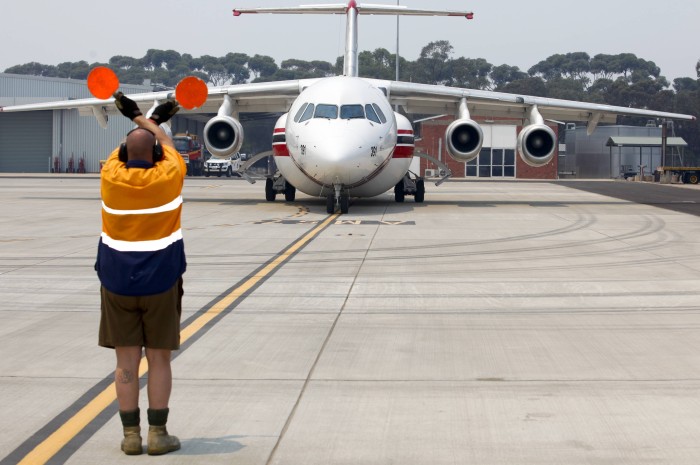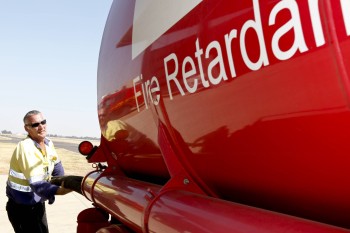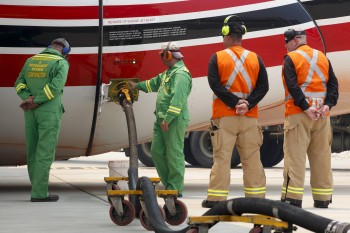RAAF Edinburgh involved in Fire Fighting
RAAF Base Edinburgh activated in quick time during the Adelaide Hills bushfire emergency in early January to provide logistics support to civilian airborne firefighting efforts.

Under a Defence Aid to the Civil Community (DACC) task, the base stood up from January 4-7 in response to a formal request by the Government of South Australia, through Emergency Management Australia, to provide refuelling, air movements and water replenishment support to firefighting aircraft from Victoria.
It was the first time the Government of South Australia had requested Defence support under the Commonwealth Disaster Plan.
Within two hours of the formal request on January 3, Edinburgh personnel began preparing for airfield air base operations, and within 12 hours, were supporting civil aircraft out of the base.
Two large contracted air tankers and a bird dog aircraft deployed from Avalon Airfield to Edinburgh on January 4 to assist South Australia’s Country Fire Service. More than 10 aircrew and support staff from Victorian fire agencies also deployed.
A contracted fire retardant mixing plant was also transported to Edinburgh from Victoria and established on base to support aircraft operations.


24SQN T/ABXO WGCDR Norman Kent, who managed the base support task, said thanks to the efforts of a small hard-working team of Edinburgh personnel, the aircraft went straight to work after arriving on base.
“We may have only had a small footprint but it was a very short-notice fluid situation and we were able to respond rapidly to provide the support required,” WGCDR Kent said.
“The success of the task would not have been possible without our refuelling and air movements personnel and the base firefighters from Transfield, who knew what needed to be done on the ground and did it quickly.
“This included establishing the fire retardant mixing plant, which was an unknown when it first arrived on base. Through innovation and hard work, they got it connected up and operating like a fuel station in just two hours – ready for the aircraft when it arrived from Avalon.”


WGCDR Kent said the rapid rate of aircraft operations was also something out of the ordinary.
“By the end of the first day, which was effectively only half a day, there had been 10 aircraft movements, with the air tankers averaging a turnaround time of just 25 minutes,” he said. “The turnaround time was from when the aircraft took off from Edinburgh, dropped its load on to the fire, came back, reloaded and returned to the fire ground again. “These aircraft had only just virtually taken off when 10 minutes later, they were landing again having completed their task. It was quite remarkable.”
Victorian Country Fire Authority Aviation Officer Wayne Rigg, who deployed with the aircraft, said the short-notice support provided by Defence was instrumental.
“There is no way we could have been as effective in supporting the South Australian community without Defence,” Mr Rigg said. “The agility and flexibility of Edinburgh staff to support these air tankers allowed us to arrive and immediately scale up operations and get to work. “To do this out of a civilian airfield with the same resources, like fuel, water, marshals and facilities, it would have taken us between 48 and 72 hours to establish operations. “In terms of resources, equipment and professionalism, this was all ready to go by Defence which made a big difference in being able to integrate into the fires very quickly.”
Over the four days at Edinburgh, 23 base personnel were assigned to the DACC task, 35 aircraft movements were supported, 320,000 litres of water was provided for the fire retardant mixing plant and 14 refuels were conducted, supplying more than 50,000 litres of fuel to the aircraft.


From the CFS-SA presentation to RAAF in recognition of their efforts during the emergency.
Chief of CFS-SA Greg Nettleton made a special trip to RAAF Base Edinburgh on January 21 to present a Chief Officer’s Certificate of Appreciation to the base and thank all the personnel involved in the Defence Aid to Civil Community (DACC) task.
“When I came out here to visit during the course of the fire I was advised that a whole lot of people were ready and willing to help out so I wanted the opportunity to come and personally thank you all for that,” Mr Nettleton said. “Some of those no-notice deployments, particularly at that time of year are quite difficult to pull off but you certainly did a fantastic job and your support was much appreciated.”
He said over the airborne operation, 31 aircraft were used to fight the fires, but the DACC operation out of Edinburgh marked a number of firsts.
“The event that occurred here was the first time the large air tankers were being used in Australia but it was also the first time they had been deployed out of Victoria and the first time that they had operated out of a RAAF base in Australia. So you have all been part of the history, if you like, in the RAAF supporting the large air tankers on operational deployment, but you have also made history on this base because you were the first ones to do it.
“Overall, [the DACC task] went absolutely seamlessly; the planning came together exactly as we expected and it did have an effect on the ground as well as the fire didn’t extend beyond the control lines we put in – partly because of the work we were able to do with those large air tankers.”
Credits: Defence Media


